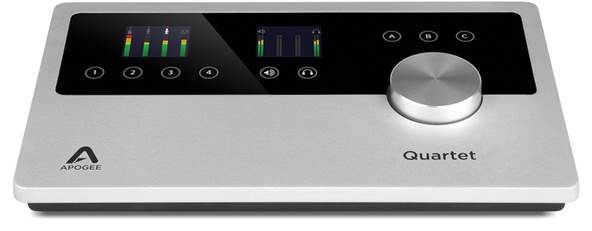Our Technical Editor finds Apogee’s all-in-one USB-based I/O
device without compromise—truly a portable I/O built to meet to professional
standards.
Imagine a very-high quality, four-channel preamp, complete
with DIs. Then throw in 24-bit, 192 kHz converters and a monitor controller
capable of handling three sets of stereo speakers or 5.1 surround. Add to that
Optical Ins (x2), MIDI capability and a WC Out. Plus a very powerful headphone
output to boot. Bundle it all in a sleek, polished, aluminum package and sell
it for less than the cost of a nice four-channel preamp. If you can imagine all
that, you’ve just realized the value of the Apogee Quartet.

As Miles mentions
in the video, connecting your Apogee Quartet to the iPad is as simple as
plugging in the cable
Features
This compact unit looks like a monitor controller, with all
the switching concealed in the glass faceplate and a single alpha knob on the
front. Clearly inspired by Apple’s design team, its clean lines and silver
finish look perfect next to an iMac/Mac Mini or even an iPad (as pictured), and
due to its larger back panel, it thankfully doesn’t rely on breakout cables
like its siblings, the Duet or One. It requires its own power supply, but it
won’t activate until connected to a USB-2 host, like my Mac Mini or iPad or
iPhone: I used it in all three configurations. Each of the four
XLR/quarter-inch combo inputs. accommodate line in (switchable +4 or -10), Mic
(+48 VDC/polarity both switchable) or Inst. The Maestro software (required)
allows control of all switching and routing, along with selecting sample rate
and Soft Limit On/Off, and has metering and a mixer built in, as well as
allowing grouping of inputs for level control. Three programmable touchpad
buttons allow for multiple user selections like Mute, Dim, Sum to Mono, Clear
Meters, and Engage speaker set.

Apogee Quartet -
rear panel Apogee Quartet - Side panel
In Use
I connected it to my 64 GB iPad 4 using the supplied cables
(Apogee’s own mini-B USB-to-standard USB Type A, or the Apogee-to-Apple 30-pin
for my iPhone 4 with the 30-pin-to-Lightning adapter), recorded into Auria and
monitored over headphones. I recorded drums and piano separately in the studio
and was honestly startled by the results very pleasantly so. For this
recording, I was consistent with my belief that the most critical part of the
signal path is right up front: Having a great drummer and good sounding kit
will get you 70 percent of the way there. So I used an Audio-Technica ATM25 on
the kick, an SM57 on the snare and two Neumann U47s for overheads. All of these
went straight into the mic inputs on the Quartet. I set the levels and hit
record, with no EQ or processing. Very impressive. Would I love to have my
other favorite outboard processing on them as I recorded? For a real record,
you bet. There’s not an easy way to do that since the preamps are built-in and
there is no insert path available, but the sounds were solid and I could easily
modify them in software or by routing out for EQ or compression. On piano, a
Yamaha C7 with the lid removed, I used two DPA 4041 mics into the Quartet. With
this solo piano piece, again, I was very impressed. This was after a session
where I was tracking drums and piano with Groove Tubes VIPRE, Shadow Hills
Gama, API 512 and Gordon Mk V preamps. While the Quartet is certainly not in
the same sonic league as those (or price league—the Gordon and VIPRE cost 2-4
times as much just for one channel), the fact that the Quartet was respectable
by comparison says a lot.

All of these went
straight into the mic inputs on the Quartet
|
The Specs
·
Apogee Quartet
·
4 Analog Inputs:
Ø
Combination line (balanced +20dBu max)
Ø
Mic/Instrument (+20dBu/+14dBu max)
Ø
4 Microphone preamps with up to 75dB of gain
Ø
Selectable 48v phantom power, Soft Limit and
phase invert
·
Digital Inputs:
Ø
ADAT/SMUX Input, 8 channels, 2 Toslink
connectors, 44.1kHz to 96kHz
Ø
MIDI input (USB-A type connector)
·
8 Analog Outputs:
Ø
6 Balanced line outputs, +20 dBu maximum
output level
Ø
1 Independent 1/4” stereo headphone output
·
Digital Outputs:
Ø
MIDI output (USB-A type connector)
Ø
Word clock output on BNC connector
Ø
A/D and D/A conversion: 24 bit/192kHz
·
2 top panel high-resolution OLED displays
·
6 touchpads for direct selection of inputs and
outputs
·
3 assignable touchpads to control:
Ø
Mute Outputs
Ø
Dim Outputs
Ø
Sum to Mono
Ø
Clear Meters
Ø
Engage Speaker Set (allows monitoring of up to
3 pairs of speakers)
·
Mic Pre:
Ø
EIN: 128dB (un-weighted) @ 60dB, 150Ohm input
Ø
Max input level: +20dBu
Ø
Input impedance: 3KOhm
·
Hi-Z:
Ø
Max input level 14 dBu
Ø
Input impedance: >2MOhm
·
A/D conversion:
Ø
Max input level (+4dBu ref): +20dBu
Ø
Max input level (-10dBV ref): +6dBV
·
Input impedance: 5KOhm
·
Freq resp 20 Hz -20Khz: > +/-0.2dB
(@44.1Khz)
·
Rel. THD + N: -106dB (@ 96Khz)
·
Dyn. Range: 114dB (A-weighted)
·
D/A conversion:
·
Max output level (+4dBu ref): +20dBu
·
Max output level (-10dBV ref): +6dBV
·
Line output impedance: 90 Ohm
·
Max output level headphones: 19dBu
·
HPH output impedance 30 Ohm.
·
Freq resp 20Hz -20 Khz: > +/- 0.05dB
(@44.1Khz)
·
Rel. THD+N : -113dB (@96Khz)
·
Dyn Range: 123dB (A-weighted)
|